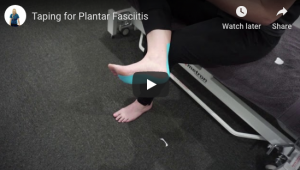05 Sep Plantar Fasciitis
Think you might have it? Here’s what you need to know…
What is it: The plantar fascia is the tissue that connects your heel to your toes. Plantar Fasciitis (also known as Plantar Fasciopathy) is when the tissue is overloaded and becomes swollen and sensitive to load.
Cause: The main cause is a sudden increase in load (e.g running more often or starting a new job that involves standing a lot). Other factors that may contribute include reduced toe/ankle range (e.g from a previous ankle injury), weight gain/high BMI and poor footwear.
Signs & Symptoms: There is pain at the inner part of the heel which is tender to touch and may be swollen. Often the pain is worse on the first few steps in the morning or after sitting for a while, which then tends to settle as you walk.
Confirm diagnosis: Symptoms are usually enough to confirm the diagnosis and imaging is not usually needed as it would not typically change what you do to manage it. If the pain is not improving then an ultrasound or MRI can help to determine if there is another cause other than plantar fasciitis (such as a stress fracture) that is actually causing your pain.
How to treat it: In the early phase the goal is to settle the pain, then work into increasing the capacity of the tissues to handle load through a gradual loading program. This may involve a period of rest early on, but then working gradually back into activity. A useful taping technique to help decrease the pain in the early phase can be found here.
It doesn’t mean you need to stop all activity until there is no pain. For example with running, for some it is ok to keep running as long pain remains less than 2/10 and your pain returns to normal levels the next day. Running on soft surfaces and on flat ground is also another way to decrease the load on the tissue. Losing weight will also help with those related to high BMI.
Specific strengthening and stretching exercises are important in helping treat plantar fasciitis which should be completed under the guidance of a physio. To find a physio in your area of Australia or New Zealand click here. I share some of my favourite exercises for plantar fasciitis in my next post (click here).
Recovery time: Depending on how much you are able to limit aggravating factors such as standing, recovery can range from a few weeks to many months.
Products: An orthotic may provide some symptomatic relief in the early phase but should be used under the guidance of a physio.
Remember to sign up to my mailing list or follow me on Facebook or Instagram for regular physio tips.



